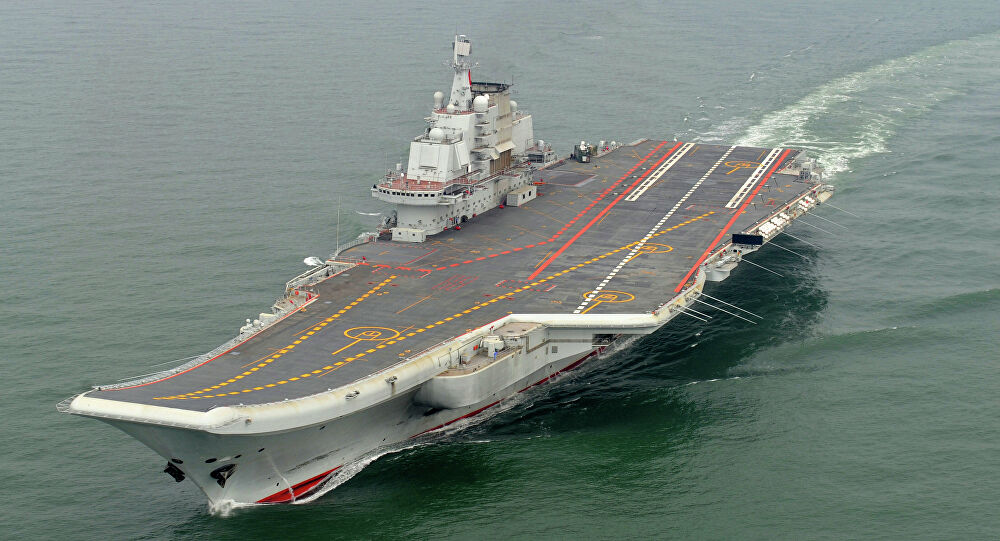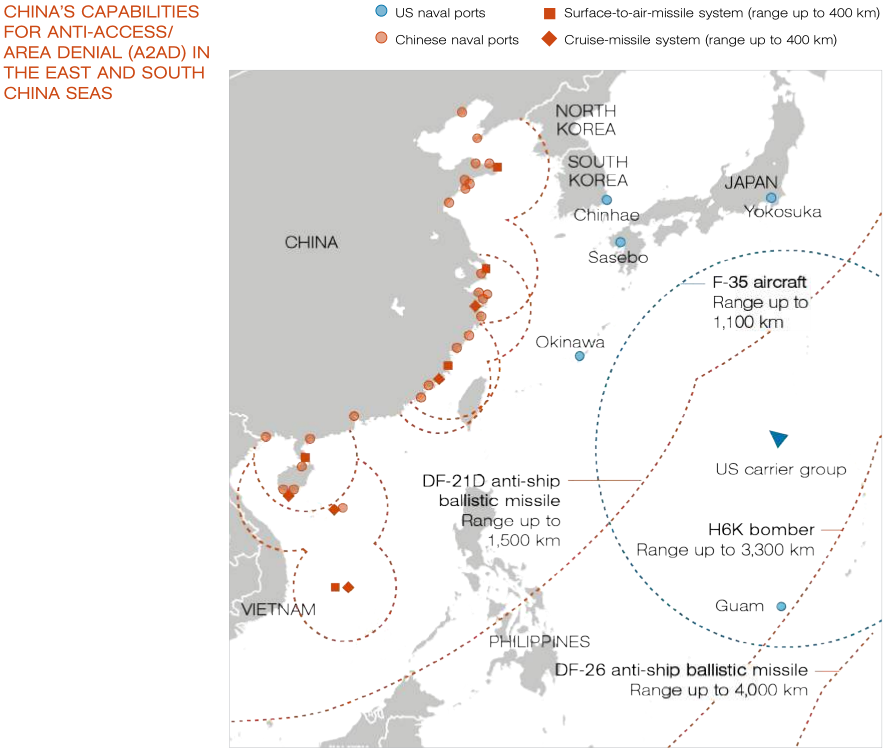The report of the Munich Security Conference looks into various potential adversaries of the Western establishment.
One of them is China, in a very quirky way (and not at all in a very biased manner) named the “Meddle Kingdom.”
A main concern is the East and South China Seas, and Beijing’s ability for anti-access/area denial (A2AD) of the region.
The Chinese government released a white paper in July 2019 denouncing “growing hegemonism, power politics, unilateralism” and provocations in China’s neighborhood by the United States, with the clear message: China is prepared to push back. In the same spirit, Beijing is continuously developing capabilities to project its power in the Asia-Pacific.
The report also repeats a very frequent propaganda piece, saying that China is specifically developing capability to strike the US’ military base in Guam.
“It has upgraded outposts in the South China Sea, is constructing a third aircraft carrier, and has developed a “credible” sea-based nuclear deterrent and ballistic missiles that could target the US base on Guam.”
These moves are also the backdrop for military posturing and hardening rhetoric toward Taiwan, with vows to take “all necessary means” to quell “separatist forces.”
At the same time, Taiwan’s harsh rhetoric towards mainland China is unmentioned.
According to the report, of course, China’s conduct in the East and South China Seas isn’t the only worrisome thing.
“A growing list of interventions – from manufacturing international praise for the mass internment of China’s Uighurs, to arbitrarily jailing Canadians in retribution for Canada arresting a Huawei executive, or censuring the US National Basketball Association – has shown countries how far China will go to stifle criticism not only at home but also abroad.”
The US is actively attempting to counter China, but other countries need to pick up the slack, according to the report.
Since, it is quite worrisome that on October 1st, when the People’s Republic of China celebrated its anniversary, President Xi Jinping had the chance to flaunt China’s continuing rise towards normative, economic, and military power on par with the West.
And it is understandable, how dare China develop as a country, both militarily, economically and so on. It is simple unacceptable to attempt and undermine Washington’s hegemony.
The report itself presents the situation in a very biased manner, and entirely misrepresents the attitudes shown during the conference by the European countries. European leaders mostly showed skepticism in following US policy through to the end, since Washington continues to prove itself as a disloyal partner, whose main interest is furthering its own interests at any cost.
MORE ON THE TOPIC:






USA can transform China into Yemen/Afghanistan in few days.
Why not the US boss class has turned much of the US into a wasteland.
We are no infants anymore, burry your GI Joe fantasies my friend.
“The report itself presents the situation in a very biased manner, and
entirely misrepresents the attitudes shown during the conference by the
European countries. European leaders mostly showed skepticism in
following US policy through to the end, since Washington continues to
prove itself as a disloyal partner, whose main interest is furthering
its own interests at any cost.”
True. Even corrupt EU bureocrats dont want to join US in their china cold/hot war. Good luck US with that…
There are several increasingly probable scenarios that may result in a US-allied war against the PRC.
US-Taiwan moves towards partition from the PRC (in violation of the One China policy) are moves towards war (recognising the contents of the PRC Anti-Secession Act).
Another scenario is a war against the DPRK necessitating an intervention by the PRC:
– “the nations they [President Trump and Chinese President Xi Jinping] lead are on a collision course for war….. U.S. war planners have examined scenarios for North Korea that begin with regime collapse. As the country descends into chaos, U.S. forces would try to destroy weapon systems capable of delivering a nuclear warhead against South Korea, Japan or Guam. The U.S. Joint Special Operations Command has a long-standing mission to secure “loose nukes” and has trained to enter the North to take control of its nuclear weapons facilities….. trying to secure North Korea’s nuclear weapons would result in a “vertical track meet” between Chinese and U.S.-South Korean forces…… Because U.S. troops and aircraft stationed in South Korea are integrated with South Korean troops in operational military plans, American and Chinese troops would then engage one another directly” (Comment: How Trump and China’s Xi could stumble into war, The Washington Post, Graham Allison, 03/04/2017)
As the US is largely replicating the format applied against Iraq (preceding war), the eventual outcome is also likely to be war. While Iraq sought to accommodate expanding US demands (that some US analysts have stated were intentionally engineered to produce a war, the expanding demands having a logical conclusion of eventual failure of negotiations, being the intention of the pro-war lobby), the DPRK has learned from this. The policy to develop their deterrent/retaliatory capabilities is the result. Unfortunately as the US is uncompromising in achieving ‘regime change’ (ongoing economic strangulation operations being an aspect of these efforts), intensifying US efforts towards this objective are actions that increase the probability of war.
p2. Key US allies are also integrated into contingency/operational plans. For example:
– “The report [‘Australia-Japan-US Maritime Cooperation’ by the Centre for Strategic and International Studies] contains specific recommendations to enhance “inter-operability” on intelligence and surveillance, submarine and anti-submarine warfare, amphibious forces and logistics….. The report’s author, Andrew Shearer, is a senior figure in the Australian foreign policy and military establishment…. Shearer is also very well connected in Washington [and] makes clear [the] main “hard security” objective is to prepare for war with China. The Pentagon’s preoccupation with “freedom of navigation” and China’s A2/AD [Anti-Access, Area Denial] systems flows directly from its military strategy for war with China—Air Sea Battle…. Australia and Japan are central to Air Sea Battle and associated strategies, which include a naval blockade of China to strangle its economy…… [Air Sea Battle] relies on networked, integrated forces to take the offensive across air, maritime, land, space and cyberspace…..” (CSIS report argues for strong US-Japan-Australia alliance against China, WSWS, 9 April 2016)
– “the Australian military is being integrated into the US military’s AirSea Battle doctrine. Under this plan, US forces will launch attacks on the Chinese mainland, while Australian forces will cut off China’s maritime trade links with the Middle East and Africa, starving its economy of oil, gas and other essential resources.” (Sydney’s week-long military extravaganza foreshadows new wars, WSWS, 11 October 2013)
It is worth noting there are reports that indicate an expectation of an ‘inevitable’ military conflict. For example:
– “The US military-intelligence complex is engaged in systematic preparations for World War III. As far as the Pentagon is concerned, a military conflict with China and/or Russia is inevitable, and this prospect has become the driving force of its tactical and strategic planning…. Each of the hearings presumed a major US conflict with another great power (sometimes unnamed, sometimes explicitly designated as China or Russia) within a relatively short time frame, years rather than decades.” (Washington prepares for World War III, WSWS, 5 November 2015)
– “According to a report in China Military Online, escalations between the two superpowers will lead to the inevitable. “The problem is not whether the war will break out, but when,” the report said.” (New Arms Race: China, US Prepare for Missile Warfare, Sputnik, 24/08/2016), etc….
Japan, Australia and S Korea are being integrated into US missile architecture. Importantly key ABM/BMD systems have offensive capabilities.
– “the Russians have always known the “shield” is a sword….. Mk-14 canisters containing Tomahawk cruise missile have the same dimensions as the [Mk-41] din that launches the anti-ballistic missle SM-3 block 1b…… American technology enables also replacing the Mk 142 kinetic cargo of rocket missile SM-3 Block 1b with the miniature nuclear warhead W80, from the cruise mini-rocket AGM-86 ALCM (which has the same mass as the SM-3 Block 1b). ” (US Anti-Missile Shield or Sword?, Valentin Vasilescu (Katehon), 23/06/2016)
– “BAE Systems [is manufacturing] Mk 14 Mod 2 Tomahawk missile launching canisters for the U.S. Navy. The canisters will [enable] loading of the U.S. Navy’s Tactical Tomahawk Missile for firing from the Mk 41 Vertical Launching System (VLS).” (US Navy Orders New Mk14 Tactical Tomahawk Missile Launching Canisters, Deagel, April 28, 2008)
Whether war is inevitable or highly probable, Chinese analysts are no doubt aware that these developments (war preparations by the US and its key allies) are an increasing threat to its national security which will require the implementation of counter-measures (including strategic policies). Many analysts have stated their recognition that forms of warfare are active. The structure of US-allied actions indicate accelerating preparations for more advanced stages of conflict.
Note: It is reasonable to assume in the event of a war, alliance architecture by all involved parties would be activated.
The problem for the U.S. (in their national psyche and mentality terms) is that both WW1/WW2 benefited them as a global player, due to the types of weapons that could flatten U.S. cities from range, having not been invented yet…
WW3 (or just a peer adversary conflict) most certainly won’t see the same level of luck for them.